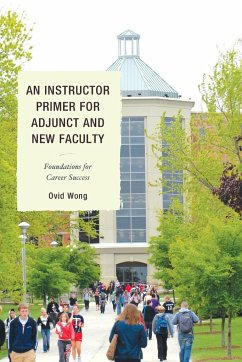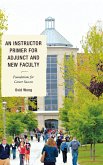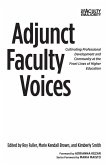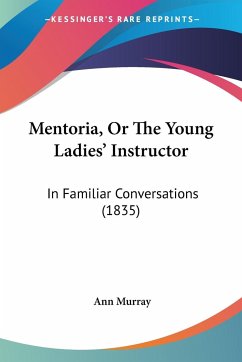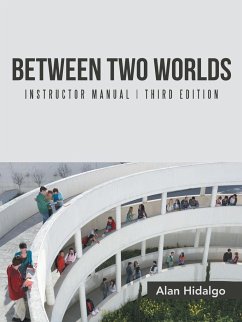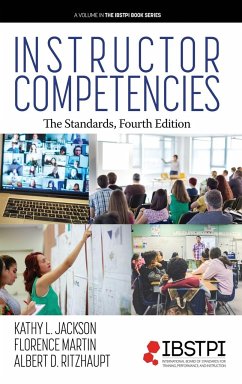- Broschiertes Buch
- Merkliste
- Auf die Merkliste
- Bewerten Bewerten
- Teilen
- Produkt teilen
- Produkterinnerung
- Produkterinnerung
Look no further if you are new to a teaching career in higher education regardless whether you are doing it full or part time. Regardless of your college role it is important to remember that the vitality and credibility of the institution is defined by the excellence of the professors that they employed.
Andere Kunden interessierten sich auch für
![An Instructor Primer for Adjunct and New Faculty An Instructor Primer for Adjunct and New Faculty]() Ovid K. WongAn Instructor Primer for Adjunct and New Faculty111,99 €
Ovid K. WongAn Instructor Primer for Adjunct and New Faculty111,99 €![Adjunct Faculty Voices Adjunct Faculty Voices]() Adjunct Faculty Voices197,99 €
Adjunct Faculty Voices197,99 €![Mentoria, Or The Young Ladies' Instructor Mentoria, Or The Young Ladies' Instructor]() Ann MurrayMentoria, Or The Young Ladies' Instructor31,99 €
Ann MurrayMentoria, Or The Young Ladies' Instructor31,99 €![Between Two Worlds Instructor Manual Between Two Worlds Instructor Manual]() Alan HidalgoBetween Two Worlds Instructor Manual51,99 €
Alan HidalgoBetween Two Worlds Instructor Manual51,99 €![Instructor Competencies Instructor Competencies]() Kathy L. JacksonInstructor Competencies105,99 €
Kathy L. JacksonInstructor Competencies105,99 €![Gender, Tenure, and the Pursuit of Work-Life-Family Stability Gender, Tenure, and the Pursuit of Work-Life-Family Stability]() Kristen E. WillmottGender, Tenure, and the Pursuit of Work-Life-Family Stability62,99 €
Kristen E. WillmottGender, Tenure, and the Pursuit of Work-Life-Family Stability62,99 €![Gender, Tenure, and the Pursuit of Work-Life-Family Stability Gender, Tenure, and the Pursuit of Work-Life-Family Stability]() Kristen E. WillmottGender, Tenure, and the Pursuit of Work-Life-Family Stability105,99 €
Kristen E. WillmottGender, Tenure, and the Pursuit of Work-Life-Family Stability105,99 €-
-
-
Look no further if you are new to a teaching career in higher education regardless whether you are doing it full or part time. Regardless of your college role it is important to remember that the vitality and credibility of the institution is defined by the excellence of the professors that they employed.
Hinweis: Dieser Artikel kann nur an eine deutsche Lieferadresse ausgeliefert werden.
Hinweis: Dieser Artikel kann nur an eine deutsche Lieferadresse ausgeliefert werden.
Produktdetails
- Produktdetails
- Verlag: Globe Pequot Publishing Group Inc/Bloomsbury
- Seitenzahl: 142
- Erscheinungstermin: 9. April 2013
- Englisch
- Abmessung: 229mm x 152mm x 8mm
- Gewicht: 217g
- ISBN-13: 9781610486507
- ISBN-10: 1610486501
- Artikelnr.: 37192869
- Herstellerkennzeichnung
- Libri GmbH
- Europaallee 1
- 36244 Bad Hersfeld
- gpsr@libri.de
- Verlag: Globe Pequot Publishing Group Inc/Bloomsbury
- Seitenzahl: 142
- Erscheinungstermin: 9. April 2013
- Englisch
- Abmessung: 229mm x 152mm x 8mm
- Gewicht: 217g
- ISBN-13: 9781610486507
- ISBN-10: 1610486501
- Artikelnr.: 37192869
- Herstellerkennzeichnung
- Libri GmbH
- Europaallee 1
- 36244 Bad Hersfeld
- gpsr@libri.de
Dr. Ovid Wong is an associate professor of education with Benedictine University, Lisle, Illinois. He is an award winning teacher and administrator with over 20 years of public school experience and he is the author of 30 books. In June 2013, Dr. Wong received Benedictine University's Faculty Award for Research.
Acknowledgment Figures Foreword by Dr. Stephen A. Nunes Introduction
Chapter 1 Welcome to the Teaching World of Higher Education Anticipatory
questions Professor taxonomy 101 What's in it for the adjunct faculty? What
are the challenges and rewards? What is your decision about joining the
adjunct faculty? What's in it for the new faculty? What is the reality?
Summary and reflection Chapter 2 Set the Stage before the First Day of
Class Anticipatory questions The course syllabus The student roster The
classroom and office The professor Summary and reflection Chapter 3 Probe
into the Minds of Learning Anticipatory questions Changing student
demography Changing teaching model Principles of adult learning The
adragogy-pedagogy continuum Summary and reflection Chapter 4 Enter the
Stage (environment) on the First Day of Class Anticipatory questions
Introduce yourself and take charge Get to know the students The course
syllabus The class routine The first teaching activity Summary and
reflection Chapter 5 Tackle the Knowledge Anticipatory questions What is a
model of knowledge? What is content knowledge? What is procedural
knowledge? What is conceptual knowledge? What is meta-cognitive knowledge?
Teaching Some Knowledge that You Do Not Know! Summary and reflection
Chapter 6 Unleash the Power of the Teaching Tool Box Anticipatory questions
Show your classroom charisma State the lesson objective The three logics of
instruction Explore the teaching tool box Lecture-based teaching
Interactive lecture-based teaching Field trip Case-based teaching
Game-based teaching Discussion-based teaching Laboratory-based teaching
Concept-based teaching A pedagogical model Summary and reflection Chapter 7
Navigate through the Magic of Questioning Anticipatory questions Start with
the basic questions Ask a combination of questions Ask intelligent
questions Wait time Summary and reflection Chapter 8 Integrate with
Instructional Technology Anticipatory questions Technology integration
expectations Simulation technology Distance learning technology Mobile
technology - iPad Student Response System (SRS) Look into the future
Summary and reflection Chapter 9 Full-circle Accountability Anticipatory
questions The professor evaluates students Objective measurement Subject
measurement Students evaluate the professor Summary and reflection About
the author
Chapter 1 Welcome to the Teaching World of Higher Education Anticipatory
questions Professor taxonomy 101 What's in it for the adjunct faculty? What
are the challenges and rewards? What is your decision about joining the
adjunct faculty? What's in it for the new faculty? What is the reality?
Summary and reflection Chapter 2 Set the Stage before the First Day of
Class Anticipatory questions The course syllabus The student roster The
classroom and office The professor Summary and reflection Chapter 3 Probe
into the Minds of Learning Anticipatory questions Changing student
demography Changing teaching model Principles of adult learning The
adragogy-pedagogy continuum Summary and reflection Chapter 4 Enter the
Stage (environment) on the First Day of Class Anticipatory questions
Introduce yourself and take charge Get to know the students The course
syllabus The class routine The first teaching activity Summary and
reflection Chapter 5 Tackle the Knowledge Anticipatory questions What is a
model of knowledge? What is content knowledge? What is procedural
knowledge? What is conceptual knowledge? What is meta-cognitive knowledge?
Teaching Some Knowledge that You Do Not Know! Summary and reflection
Chapter 6 Unleash the Power of the Teaching Tool Box Anticipatory questions
Show your classroom charisma State the lesson objective The three logics of
instruction Explore the teaching tool box Lecture-based teaching
Interactive lecture-based teaching Field trip Case-based teaching
Game-based teaching Discussion-based teaching Laboratory-based teaching
Concept-based teaching A pedagogical model Summary and reflection Chapter 7
Navigate through the Magic of Questioning Anticipatory questions Start with
the basic questions Ask a combination of questions Ask intelligent
questions Wait time Summary and reflection Chapter 8 Integrate with
Instructional Technology Anticipatory questions Technology integration
expectations Simulation technology Distance learning technology Mobile
technology - iPad Student Response System (SRS) Look into the future
Summary and reflection Chapter 9 Full-circle Accountability Anticipatory
questions The professor evaluates students Objective measurement Subject
measurement Students evaluate the professor Summary and reflection About
the author
Acknowledgment Figures Foreword by Dr. Stephen A. Nunes Introduction
Chapter 1 Welcome to the Teaching World of Higher Education Anticipatory
questions Professor taxonomy 101 What's in it for the adjunct faculty? What
are the challenges and rewards? What is your decision about joining the
adjunct faculty? What's in it for the new faculty? What is the reality?
Summary and reflection Chapter 2 Set the Stage before the First Day of
Class Anticipatory questions The course syllabus The student roster The
classroom and office The professor Summary and reflection Chapter 3 Probe
into the Minds of Learning Anticipatory questions Changing student
demography Changing teaching model Principles of adult learning The
adragogy-pedagogy continuum Summary and reflection Chapter 4 Enter the
Stage (environment) on the First Day of Class Anticipatory questions
Introduce yourself and take charge Get to know the students The course
syllabus The class routine The first teaching activity Summary and
reflection Chapter 5 Tackle the Knowledge Anticipatory questions What is a
model of knowledge? What is content knowledge? What is procedural
knowledge? What is conceptual knowledge? What is meta-cognitive knowledge?
Teaching Some Knowledge that You Do Not Know! Summary and reflection
Chapter 6 Unleash the Power of the Teaching Tool Box Anticipatory questions
Show your classroom charisma State the lesson objective The three logics of
instruction Explore the teaching tool box Lecture-based teaching
Interactive lecture-based teaching Field trip Case-based teaching
Game-based teaching Discussion-based teaching Laboratory-based teaching
Concept-based teaching A pedagogical model Summary and reflection Chapter 7
Navigate through the Magic of Questioning Anticipatory questions Start with
the basic questions Ask a combination of questions Ask intelligent
questions Wait time Summary and reflection Chapter 8 Integrate with
Instructional Technology Anticipatory questions Technology integration
expectations Simulation technology Distance learning technology Mobile
technology - iPad Student Response System (SRS) Look into the future
Summary and reflection Chapter 9 Full-circle Accountability Anticipatory
questions The professor evaluates students Objective measurement Subject
measurement Students evaluate the professor Summary and reflection About
the author
Chapter 1 Welcome to the Teaching World of Higher Education Anticipatory
questions Professor taxonomy 101 What's in it for the adjunct faculty? What
are the challenges and rewards? What is your decision about joining the
adjunct faculty? What's in it for the new faculty? What is the reality?
Summary and reflection Chapter 2 Set the Stage before the First Day of
Class Anticipatory questions The course syllabus The student roster The
classroom and office The professor Summary and reflection Chapter 3 Probe
into the Minds of Learning Anticipatory questions Changing student
demography Changing teaching model Principles of adult learning The
adragogy-pedagogy continuum Summary and reflection Chapter 4 Enter the
Stage (environment) on the First Day of Class Anticipatory questions
Introduce yourself and take charge Get to know the students The course
syllabus The class routine The first teaching activity Summary and
reflection Chapter 5 Tackle the Knowledge Anticipatory questions What is a
model of knowledge? What is content knowledge? What is procedural
knowledge? What is conceptual knowledge? What is meta-cognitive knowledge?
Teaching Some Knowledge that You Do Not Know! Summary and reflection
Chapter 6 Unleash the Power of the Teaching Tool Box Anticipatory questions
Show your classroom charisma State the lesson objective The three logics of
instruction Explore the teaching tool box Lecture-based teaching
Interactive lecture-based teaching Field trip Case-based teaching
Game-based teaching Discussion-based teaching Laboratory-based teaching
Concept-based teaching A pedagogical model Summary and reflection Chapter 7
Navigate through the Magic of Questioning Anticipatory questions Start with
the basic questions Ask a combination of questions Ask intelligent
questions Wait time Summary and reflection Chapter 8 Integrate with
Instructional Technology Anticipatory questions Technology integration
expectations Simulation technology Distance learning technology Mobile
technology - iPad Student Response System (SRS) Look into the future
Summary and reflection Chapter 9 Full-circle Accountability Anticipatory
questions The professor evaluates students Objective measurement Subject
measurement Students evaluate the professor Summary and reflection About
the author

